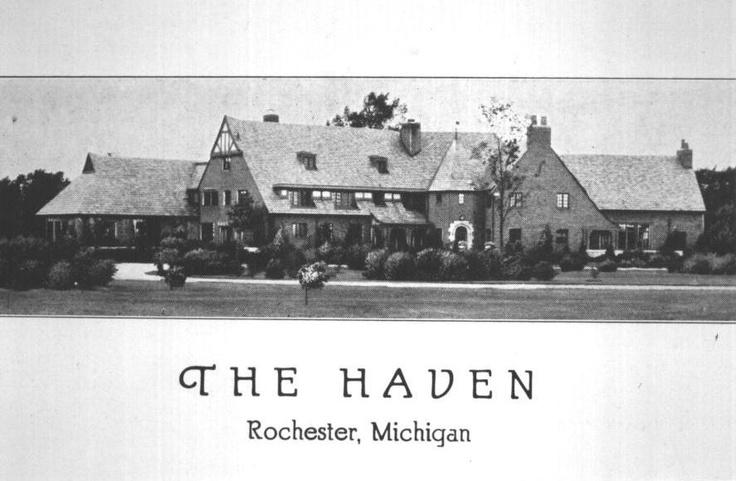Local Neighborhood Shares Location with Old Asylum
January 5, 2017
Across from Rochester High School, the neighborhood of Grosse Pines, on Walton Blvd., houses many Rochester students. What many don’t know is that this subdivision was the location of a mental asylum for 30 years in the 20th century.
“It’s pretty creepy to know that my neighborhood was a mental asylum,” said Grosse Pines resident and RHS Sophomore Courtney Pye. “But I mean I guess I’ll just have to deal with it though.”
In 1926, the Shinnick family moved to Rochester, and bought the 70 acres that the neighborhood of Grosse Pines now occupies. The Shinnicks built a huge estate called The Haven. However, when the Great Depression hit, the Shinnick family could no longer afford to maintain their mansion, so they turned it into a mental asylum. In the early 1900’s, treatment methods for mental illnesses such as lobotomies and shock treatment were used, but such practices are now seen as cruel. According to Historian Tiffany Dziurman Stozicki, The Haven was a hospital for addiction to alcohol and drugs, but didn’t use lobotomies, it also helped people with bipolar disorder and schizophrenia.
The Haven not only housed the mentally ill from Rochester and surrounding areas, but it is rumored that Hollywood celebrities, politicians and criminals including Judy Garland, Ralph Bunche, well-known murderer Richard Wishnetsky and John F. Kennedy’s niece, Rosemary were treated there.
“The wealthy and famous, children/young people, and the criminally insane,” Wendy Clem, author of The Haunted Haven Sanitarium: Home to Mystery, Movie Stars & Murder, a book about the mental asylum. “All were kept within its well-appointed floors and lovely grounds–AND it’s creepy basement that housed the more violent in solitary confinement, surrounded by jars containing body specimens.”
According to Haven visitors and workers, The Haven’s interior was beautiful. It’s outside grounds were large and elaborately landscaped. The Haven had a shot stone fence surrounding it that can still be seen today from Walton Blvd. The mansion itself boasted 30 rooms, most of which were used to house and treat patients. As described by Clem, the basement was used for patients who became violent, acquiring padded rooms. The mansion was once a deluxe house furnished with state of the art luxuries.
“The very handsome home completed a year a half ago stands back a full quarter of a mile from the road and is reached by a winding driveway. Built of red brick in old English style, it stands in spacious grounds containing 70 acres in all” said Rochester Era 1928 newspaper. “At the back of the house is a lovely rock-garden and the ground slopes down to a fine natural pool with delightful woods and a ravine yet farther on.”
The Haven’s popularity grew as Rochester developed, causing families to feel on edge about the safety of the nearby mental asylum. Sometimes the patients would escape and cause a panic in Rochester until they were found. These dangers and Rochester’s expansion caused The Haven to change its purposes to be more focused on helping Rochester Community School’s students from 1949-1968. The students who were seen as antisocial or friendless were considered mentally ill and were sent to The Haven for treatment.
“The hospital was quite advanced for its day” Researcher and Historian Tiffany Dziurman Stozicki said. “It centered around occupational therapy and was renowned for its treatment plans, as well as the doctors the Shinnick family employed to direct and manage patient care. I think the Rochester Plan for school children is fascinating. It was both somewhat outrageous (for today’s beliefs) and advanced for the time.”
The Haven’s funds were depleted, prohibiting it to continue being a treatment center for troubled kids, leading to its eventual closing down. The building remained vacant for years. Ambitious and daring teens would go there to explore or party. These teenagers, who are now grown, recap on their adventures and the details they gathered while exploring it. Chris Doliber was one of these visitors and explained how the caretaker of The Haven would run them off of the property when caught so they had to be careful when they toured the building.
“A bunch of us West Jr. high kids would gather at my house and head to the Haven, (and) the caretaker would chase us with his car through the front yard or on foot through the house whenever he discovered us there,” Doliber said. “You’re literally running in circles, and you bump into others scrambling and not knowing which way to go, (then) you run around the corner and run right into the caretaker, almost knocking you both to the floor.”
The Haven’s interior started to get rundown, and it’s grounds quite overgrown. After its closing in 1969, the caretaker and Rochester police force had to keep a constant eye on it in an effort to preserve and maintain it.
“The inside [was] damp and dusty smelling; some of the windows were broken and there was glass on the floor from that,” Haven visitor Chris Doliber said. “Other rooms had old medical equipment in it like I.V caddies and hospital beds, rubber hoses and bandages.”
In 1971, The Haven mysteriously burned to the ground. However, according to Clem, the basement of the Haven didn’t burn with the rest of the house. Still containing the padded rooms, medical equipment, and hospital beds, the basement was covered with dirt and the subdivision of Grosse Pines was built. The residents of Grosse Pines have had pipes and cables pop up out of the ground because of the erosion under the ground with the basement still being there. Of course, some believe that the neighborhood is haunted because of its eerie past.
“Landscapers talk about weird things being found in the yards of Grosse Pines homeowners that ‘wash up’ and surprise everyone, especially the homeowners,” Clem said. “And, somewhere I had heard a couple of homeowners had commented that eerie things had happened.”




Mark Hall • May 16, 2019 at 4:24 am
Wow